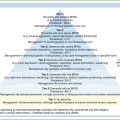Chapter 30 PHARMACOLOGICAL TREATMENT
INTRODUCTION
The introduction of effective psychotropic medications in the 1950s transformed the lives of many people with mental health problems, including many older people who would otherwise have lived out their lives in asylums. The drugs that are currently available are powerful pharmaceutical agents and all have significant potential adverse effects. This chapter introduces core concepts in clinical psychopharmacology and outlines the major classes of psychotropics used in older people in the community. It is likely to be of most interest to medical and nursing personnel, although all mental health workers do require a working familiarity with the psychotropic medications commonly used in older people.
CORE CONCEPTS IN PSYCHOPHARMACOLOGY
Psychopharmacology involves the use of medication to treat mental health and behavioural problems. The conceptual model behind the use of drugs to alter states of mind is based on the idea that a person’s mental state reflects, at least in part, the state of their brain neurotransmitter systems. Neurotransmitters are chemical messengers that allow brain cells to communicate with one another. Several neurotransmitters have been found to be suitable targets for drug treatment. These include acetylcholine, dopamine, gamma amino butyric acid (GABA), glutamate, noradrenaline and serotonin. It is beyond the scope of this chapter to provide detailed information about each of these neurotransmitter systems, but there are readily accessible sources of this information in specialised texts (e.g. Stahl 2006).
Effective psychotropic medications mostly employ one of three main mechanisms of action:
POLYPHARMACY
Polypharmacy refers to the situation in which a person is prescribed multiple potentially interacting medications. This is a common situation in older people with several chronic illnesses. Use of multiple drugs increases the risk of drug–drug interactions and of the additive effects of the adverse effects of these drugs. Sedative and anticholinergic effects due to combinations of drugs with these properties are a common problem, and often lead to confusion and falls.
PRINCIPLES OF DRUG TREATMENT
Before commencing an older person on a psychotropic drug, there are several important steps that should be undertaken. These include combining information from the psychiatric history and mental state examination (MSE) to arrive at a ‘provisional diagnosis’ of the person’s problem. In selected cases, this diagnosis might be further refined through the use of laboratory investigations and neuroimaging studies, as discussed in Chapter 15. Most of the evidence for the efficacy of drug treatment for mental health problems comes from conducting clinical trials in people with a defined mental health problem. Thus, it is important to arrive at a diagnosis before embarking on treatment with psychotropic medication. A physical examination is also important to exclude any contraindications to drug treatment. For instance, certain antipsychotic drugs might be contraindicated in older people with postural hypotension (low blood pressure on standing). It is also important to review with the person their therapeutic responses to previous treatments and any adverse effects that they have experienced in the past. A past history of response to a particular drug often provide a good indication of which drug to choose.
DRUG ADMINISTRATION ISSUES
In older people, poor eyesight and impaired cognition may increase the potential risk of medication errors. Older people also have a high prevalence of arthritis that affects their ability to open pill bottles. Several techniques have evolved to assist older people living in the community. These include the use of home medication dispensing systems, such as the Webster Pak®, and the use of daily visits from domiciliary nurses to ensure correct administration of medications. In people with less severe difficulties, the use of a ‘pill organiser’, such as a Dosette® box, can help with keeping track of daily medication use. It often helps if the medication regimen has been simplified to once daily. Prescribers should also consider carefully the route of administration. It is often safer to use transdermal delivery systems (skin patches) for potentially toxic medications, such as buprenorphine (a narcotic analgesic) or rivastigmine (a cholinesterase inhibitor medication for Alzheimer’s disease).
ANTIDEPRESSANTS
Antidepressant drugs are widely prescribed for depressive and anxiety disorders. The best evidence is for their use in major depression and generalised anxiety disorder, although they are also commonly used in other depressive and anxiety disorders. All antidepressants have similar efficacy in major depression, with approximately 70% of people showing a treatment effect in clinical trials, although 30–40% of this is a placebo effect. The number needed to treat (NNT) (see Ch 3) is between three and four. However, the effectiveness of antidepressants depends critically upon the person’s adherence to the treatment regimen. As a consequence, antidepressant effectiveness is usually considerably less than the level of drug efficacy found in clinical trials.
Although the SSRI drugs are generally safe, they do have a range of adverse effects, including:
Stay updated, free articles. Join our Telegram channel

Full access? Get Clinical Tree




